Exterior paints are reputable for their durability which is desirable quality. Even so, can you use exterior paint inside?
Here’s everything you need to know about exterior paints!
We are used to classifying paints based on their continuous phase/solvent; this gives rise to water-based vs. oil-based paints.
However, we can categorize paints in terms of external and internal use.
The latter criterion (internal vs. external use) is the center of this write-up.
The main point of contention is whether you can substitute one paint for the other. Leading to our discussion- can you use exterior paint inside?
The straightforward answer is no!
The exterior paint label on paint containers isn’t simply a nominal matter or a marketing gimmick.
It is a fundamental point with dire consequences when contravened.
Exterior paint is exclusively designated for external/outdoor use, while interior paint is meant for indoor use only.
Let’s say you paint on an indoor project like kitchen cabinets, tables, or interior walls.
Then, you unexpectedly run out of the interior paint you were using. What would be your next move? S
hould you just grab a nearby external paint and carry on painting or take the long route of purchasing new interior paint?
I’d advise you to halt/pause the project and resume only after acquiring new interior paint.
However, the best approach is to gauge if you have enough paint before you begin the project in the first.
You should have slightly more than the amount you need to rule out the probability of any insufficiencies.
The article features the definitions of exterior and interior paints and a side-by-side juxtaposition of the two.
The comparison and contrast will pivot on their properties, advantages, and disadvantages.
I’ll also discuss the following:
- Whether you can use interior paint outside
- Reasons to avoid using exterior paint for indoor projects
- The possibility of mixing exterior paint with interior paint
- The finest leading exterior paint products for wood and metal
- First-rate interior paint brands for metallic and wooden substrates
- The procedure for applying exterior wood paint
Note: For clarity, I’ve used the terms exterior, outside, outdoor, and external synonymously regarding paint.
By the same token, I’ve used the terms interior, inside, indoor, and internal interchangeably to refer to paint.
It’s an informative piece, so I encourage you to read it wholly and with utmost focus.
Only then will you benefit maximally. Let’s start.
What Is Exterior Paint?
Paints are grouped and graded in many facets. One such grouping is exterior paint, which is this segment’s focus.
I’ll base my descriptions on its properties, pros, and cons. So, what is exterior paint?
The most basic definition is that it is paint used on outdoor substrates.
Such substrates include patios, metals, roofs, fences, and external walls.
You should always check the paint container to identify outdoor paint, as most manufacturers indicate on the labels.
Properties
The characteristics of exterior paints that make them perfectly cut out for external/outdoor projects include:
- They are hard-wearing
- The paints are laced with vermin-proof chemicals.
- Exterior paints have strong adhesive properties.
- These paints are highly tolerant to extreme weather conditions like excess sunlight and deluges.
- They are formulated with fire-retardant constituents.
- Exterior paints are flexible/stretchy, courtesy of high binder proportions. It makes them resistant to peeling and cracking when the substrate undergoes thermal expansion and contraction.
- They have higher VOC levels than interior paints; however, the VOC amounts are still compliant with EPA regulations.
Pros and Cons of Exterior Paint
All manufactured products have benefits and downsides.
However, the advantages must outweigh the drawbacks to render the product beneficial.
Exterior paints couldn’t be any different. These are the pros and cons of using outdoor paints:
Pros
- It provides for easy maintenance.
- Most of these paints are easy to apply
- Exterior paint conceals surface imperfections
- It spruces up substrates
- The paints lower maintenance costs
- They come in many colors and formulations
- Exterior paints have long shelf lives
- They extend the life of your substrate
- These paints are resistant to scratching, peeling, and cracking
- Exterior paints keep away vermin
Cons
- When you want to repaint or do makeovers, exterior paint is challenging to remove. It’s due to their firm adhesion to surfaces.
- It hides the natural beauty of the substrate underneath.
- Some of them are harmful to the environment due to high VOC levels.
- High initial purchasing cost.
What Is Interior Paint?
On the other side of the comparison, we have interior paints.
Like I did for exterior paint, I’ll break down its definition into properties, pros, and cons. What is interior paint?
It’s paint that is meant for indoor or housebound substrates.
Tables, kitchen cabinets, kitchenware, floors, room walls, etc. make up such substrates.
Again, interior paint manufacturing companies display this information on the labels to save you identification troubles.
All you need to do is check before buying.
Properties
Some of the attributes that define interior paints are:
- They undergo little to no off-gassing/outgassing due to low VOC content. It makes them non-toxic.
- Interior paints are formulated with intumescent constituents. An intumescent substance swells up when heated to protect the underlying material or seal gaps to stop or mitigate a fire breakout.
- They are water-resistant, although not to the same degree as exterior paints. The water-resistance profile protects the substrate underneath from rotting and fungal growth.
- The paints are richly pigmented. It makes the decorated material more conspicuous.
- These paints are stain-resistant and easy to clean. It’s due to the smooth texture that doesn’t allow the stains to remain stuck on surfaces.
- Interior paints are easy to remove to enable surface refashioning or restoration.
- The paints can cure even without direct exposure to UV rays/sunlight. It’s because most of them are water-based.
- They don’t contain fungicidal and pesticidal additives; if they have, it’s trace levels. The pests and fungicides are more of a problem for outdoor materials.
Pros and Cons of Interior Paint
Interior paints, as expected, have their upsides and downsides. Again, the advantages outdo the flaws manifold. The details are as below:
Pros
- They are the best for decorating materials. They are richly colored and can produce special effects like optical illusions.
They can also give textured finishes.
- The paints are durable in both storage and functionality.
On storage, a previously opened interior paint will last 7 to 10 years when resealed; unopened ones last 15 years.
On functionality, an interior paint job lasts 5 to 10 years before repainting.
- It makes the painted material easier to maintain. The covered material doesn’t need constant cleaning as the paint is stain-resistant.
In the case of painted metals, you also don’t have to worry about corrosion or rusting. As such, the material maintains its new look.
- Even though interior paints are not as tough/robust as exterior paints, they offer scratch resistance, trauma resistance, and water resistance.
They protect the underlying material. It prevents rot and physical & chemical damage to the substrate.
- Interior paints are well-priced relative to their output.
- These paints are easy to mix and spread. It makes their application effortless.
- The paints are good at hiding surface defects.
Cons
- Interior paints mask the pristine beauty of some substrates.
- The paints are not as durable and hard-wearing as outdoor paints.
- It’s challenging to clean up after using interior paints because the working station is indoors.
Can You Use Interior Paint Outdoors?
Paints are popular for their universal applications. A given paint can go over furniture, concrete, plastics, and other surfaces.
But where do we draw the lines? For instance, can you use interior paint outdoors?
It’s a no! Or rather, you shouldn’t. Interior paint is formulated for indoor projects; that’s the reason it is so named.
While nobody can stop you from using indoor paints on exterior-based surfaces, it’ll cause immediate and long-term consequences.
The immediate negative outcome is it is labor intensive as you’ll need to lay down several coats of the interior paint.
Secondly, it will leave brush marks on the substrate because the paint’s consistency isn’t customized for exterior application with firm bristle brushes.
The gravest outcomes of the above misuse become apparent in long-term evaluations.
The paint fades away rapidly, peels/distresses, and yields easily to the harsh environmental elements.
It leads to poor durability performance, high maintenance costs, and frequent repainting.
Interior paints don’t have the same constituents as exterior paints, and the ones found in both paints aren’t in the same proportions.
For instance, interior paint does not contain vermin-proof chemicals.
The chemicals are also harmful, but not deadly, to humans.
Additionally, indoor paints contain low amounts of binders/resins.
Binders are the film-forming components of paint; they impart toughness, durability, and flexibility to paint.
It means you need them in high proportions for outdoor use, effectively contraindicating interior paint for outside use.
Why You Should Not Use Exterior Paint Inside
So far, I’ve dissuaded you from using exterior paint indoors without giving reasons.
It’s about time I defend that stance. I’ll discuss why you should not use exterior paint inside in this section.
The reasons are as follows:
VOC Levels
Exterior paints contain high VOC levels.
VOCs are volatile organic compounds, and they are released in a process known as off-gassing.
Excess inhalation of the above compounds leads to respiratory problems and hypersensitivity reactions.
Using exterior paint inside only worsens the problem due to poor ventilation and frequent exposure.
Pigment Proportions
Outdoor paints contain low amounts of pigment. Therefore, they are not the best choice for substrate decoration.
One of the main reasons for painting indoor materials is for adornment. Interior paint has the correct pigment ratios to cut.
Insect & Vermin Repellents
External paints have high concentrations of insecticides and vermicides.
These agents are also toxic to humans, especially toddlers, who are known to explore their surroundings by tasting.
Also, using outdoor paint on kitchen materials can contaminate their contents and cause food poisoning.
Interior paints don’t contain the above chemicals, so you can use them on food-grade materials.
Waste of Time and Money
Using external paint inside wastes time, energy, and resources.
First, you’ll find it challenging to apply due to paint-substrate incompatibility.
In the long run, you’ll have wasted the paint and money because you’ll need to replace it with interior paint.
Overall, using outdoor paint inside doesn’t sound right from the get-go.
You can try it, but there’s an absurdity to it now that the container is clearly labeled “exterior paint.”
It’s like applying cooking oil instead of body lotion to your skin. It’s possible but illogical.
Can You Mix Exterior Paint With Interior Paint?
Sometimes, your needs may straddle the advantages of both paints. But you need to materialize these needs.
How? Can you mix exterior paint with interior paint? That’s the focus of this segment.
Well, it depends on the substrate you’re working on. Why not if it requires a blend of characteristics from both paints?
However, in most cases, I’d advise you not to mix them as it will lead to the following consequences:
Shorter Shelf Life
Mixing paints, especially those designed for different uses, reduce their viability.
The blending degrades the preservatives in both paints, thus predisposing them to deterioration.
Uneven Finish
Combining the two paints can manifest in an uneven appearance on the painted surface.
It comes about due to unmatched sheen levels, solvent quality differences, poor mixing ratios, and other inconsistencies.
High VOCs
Blending external paint with indoor paint increases the VOC levels of the latter.
The outgassed compounds will affect your breathing if you use the resulting mixture for in-house projects.
It gets even worse for those with underlying respiratory conditions like asthma.
The above are the main problems that can beset the idea in question.
At times, the negatives converge on a given paint admixture.
When it happens, the paint becomes unusable, so you must dispose of it and purchase new paint.
My final stand on the above is you should avoid mixing the two because the looming consequences are too costly.
Best Exterior Paints for Wood
This marks the beginning of the name-dropping segment!
Every paint category has first-rate, second-rate, and standard products.
Let’s start with the best exterior paints for wood.
I will showcase only the top-quality ones.
-
Wolman Outdoor Furniture Paint
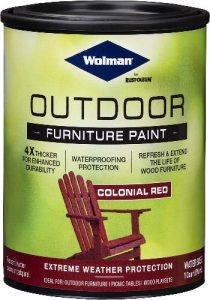 Wolman external wood care products are made to shield and augment the aesthetics of wood decks/patios, outdoor furniture, fences, and siding.
Wolman external wood care products are made to shield and augment the aesthetics of wood decks/patios, outdoor furniture, fences, and siding.
It is durable, rich-colored paints in premixed tints and their bases, making it easier to find the exact color you’re looking for.
The Wolman brand is cherished by professionals, students, and DIY enthusiasts due to its top-quality products.
One such product is the above-named exterior furniture paint.
It has the edge over other external wood paints due to the following advantages and features:
- It is hard-wearing
- This paint is available in many colors
- The paint dries to a water-resistant coat
- It comes in 32 fl oz cans
- Wolman outdoor paint is available as oil-based and water-based formulas
- The paint comes in different opacities, i.e., solid, semi-transparent, and transparent.
-
Prestige Lifetime Exterior Paint & Primer In One
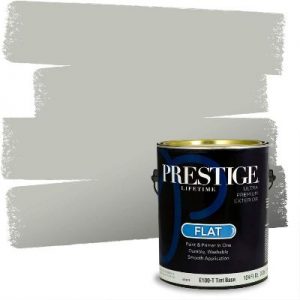 Prestige Paints lets consumers purchase American-made, low VOC, top-grade paints online through Amazon.
Prestige Paints lets consumers purchase American-made, low VOC, top-grade paints online through Amazon.
The orders are also delivered to your doorsteps through Amazon within two days! Pretty convenient, right?
The said company makes countless paint colors with varying gloss levels.
What’s fascinating is that you can pick your preference from the screen of your laptop, smartphone, or tablet.
One of their best products is the above-mentioned exterior paint and primer in one.
It has the following benefits and features:
These are the benefits and features of this paint:
- It’s a paint and primer in one, so it saves you the time and cost of priming before painting
- Prestige lifetime exterior paint is easy to clean as it is 100% acrylic latex; you only need soap/detergent and water
- The paint is easy to apply and has excellent surface coverage
- This paint has a low VOC content
- It is water-resistant to keep away mildew and mold growth
Best Exterior Paints for Metals
Metals and wood form the majority of painted substrates worldwide.
Therefore, knowing the paint products and brands that suit them is crucial.
I’ve already covered the ones for wood in the preceding subtopic. In this section, I’ll feature the best exterior paints for metals.
-
Rust-Oleum Stops Rust Protective Enamel
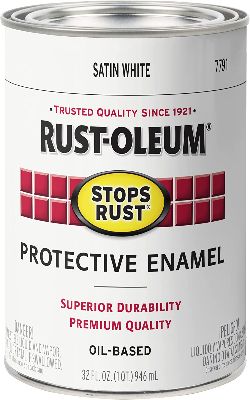 Rust-Oleum makes the above product.
Rust-Oleum makes the above product.
The company has specialized in manufacturing coatings and paints for industrial and home use.
Robert Ferguson founded it in 1921 after noticing that fish oil spills on corroded metal stopped the rust from spreading.
Many changes have been made since then to make high-quality painting products using resins from alkyds, epoxies, polyurethanes, latex, etc.
One of their best is the oil-based Rust-Oleum Stops Rust Enamel paint. It has the following upsides and attributes:
- Rust-Oleum Stops Rust is hard-wearing and durable. It’s because of its oil-based formula
- The paint prevents corrosion of metals
- This paint doesn’t fade quickly. It helps to maintain the original color and appearance of the finish.
- It dries quickly and has superior coverage of 400 square feet per gallon
- The paint scores high on a cost-benefit analysis
- It gives a smooth finish that resists abrasion and chipping
- The paint is easy to spread
-
Rust-Oleum Professional High-Performance Enamel
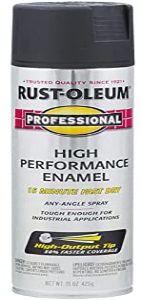 As mentioned in the preceding text, Rust-Oleum Company is an astral member of the painting fraternity.
As mentioned in the preceding text, Rust-Oleum Company is an astral member of the painting fraternity.
It’s top in Canada and the US in decorative, rust preventative, professional, and specialty painting segments; the inference is based on market share.
Moreover, the Chicago Tribune, a highly reputable daily newspaper, rated Rust-Oleum among the leading mid-sized workplaces in 2013, 2014, and 2015.
Their professional high-performance enamel paint has these advantages and qualities:
- It has a rust-preventative formula to arrest corrosion, thereby maintaining the structural integrity of metallic substrates.
- This product comes in 128 fl oz cans that will last you through several painting projects.
- It is an oil-based formula; this makes it highly tolerable to physical stress and distressing.
- Rust-Oleum Professional Enamel paint gives a smooth finish.
- The paint has a high user-friendliness rating.
- This paint is easy to clean when wet.
Best Interior Paints for Wood
Indoor substrates need equally important painting regard as exterior materials.
Internal wood and metals still dominate the number of workpiece materials for the above undertaking.
As a consequence, most interior paint brands target indoor wood and metals.
I’ll start by discussing the best interior paints for wood.
-
INSL-X Cabinet Coat Enamel
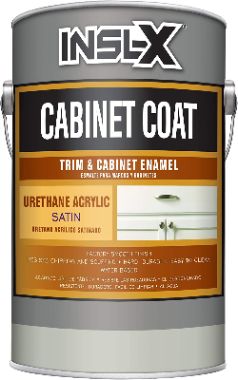 The above product is manufactured by INSL-X®, under Benjamin Moore & Co.
The above product is manufactured by INSL-X®, under Benjamin Moore & Co.
The company is famed for specialty, architectural, and industrial paints, primers, & coatings.
Their longstanding success in the above quarters makes them the consumer’s favorite destination.
The cabinet mentioned earlier coat enamel paint has seen a significant increase in interior furniture painting due to the following reasons:
- It’s ideal for indoor furniture like shelves, trims, chairs, crown moldings, and tables
- The paint gives an ultra-smooth, long-lasting finish
- INSL-X cabinet coat enamel has excellent substrate coverage of 350-450 square feet per gallon
- This is a hard-wearing urethane acrylic formula hence the tough, trauma-resistant finish
- It has superior adhesive properties. You can use the paint even without priming.
-
Country Chic Chalk Style Paint
Country Chic manufactures impressive furniture paints for touch-ups and home decor.
It’s a go-to for DIYers and homeowners who like quaint and distressed furniture.
The most exciting bit about their paints is that they can go over the wooden substrates without prepping.
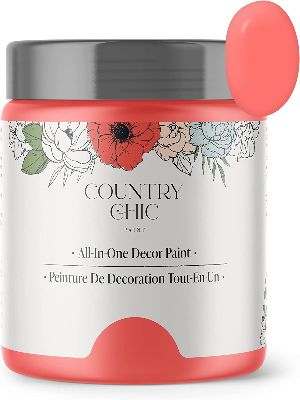 Their products are mainly used to restore antique art pieces in museums and to decorate sculptured wood for sale.
Their products are mainly used to restore antique art pieces in museums and to decorate sculptured wood for sale.
One of the best in their collection is the above-named chalk-style paint. These are its qualities and benefits:
- The paint is packaged in 4 fl oz containers, perfect for small indoor painting projects.
- Country Chic’s chalky paint gives a matte finish to simulate a picturesque look.
- This paint incorporates a built-in primer and top coat; the primer promotes adhesion while the top coat reinforces its structural integrity.
- Country Chic chalked paint ranks among the best in the eco-friendly and safety index. It has no formaldehyde, phthalates, heavy metals, and VOCs.
- The paint has short drying times of around 30 minutes.
- It is easy to apply.
- Country chic paint is available at a budget-friendly price.
Best Interior Paints for Metal
This is the last segment dedicated to mentioning the leading paint brands.
This time, I’ll focus on the best interior paints for metal.
To reiterate, always check the paint can or container label to purchase the right one. These are the products:
-
Majic Paints Diamond Hard Acrylic Enamel
Majic Paints has been in the paint and coatings manufacturing business since 1920.
Their portfolio spans oil-based paints, latex paints, acrylics, spray paints, and wood finishing products.
The company also makes various industrial, farm, home, and specialty products.
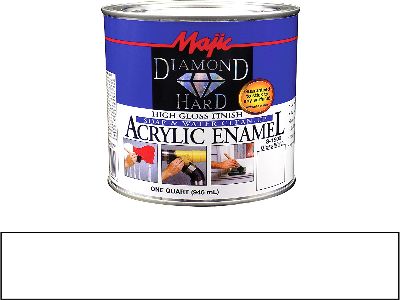 All of the above products are manufactured in the US, and the company has an in-house marketing unit to streamline sales and customer relations.
All of the above products are manufactured in the US, and the company has an in-house marketing unit to streamline sales and customer relations.
The hard acrylic enamel works perfectly on interior metals due to the following reasons:
- It has a broad surface coverage of 450 sq ft per gallon
- The product comes in 8 fluid oz (half-pint) cans, ideal for small painting projects
- This paint comes in various colors and sheens, including dark brown, black, royal blue, charleston green, and white
- It is a low odor non-flammable paint
- The paint gives a hard-wearing acrylic finish
- Majic Paints diamond enamel paint inhibits rust
- It has excellent leveling properties
-
Diamond Brite Industrial Aluminum Paint
Diamondbrite® belongs to the Jewelultra Ltd Company.
They manufacture an array of specialized paints and chemicals that target the janitorial, industrial, and motor markets.
The company was founded in 1992 and has seen a constant rise through the paint brand ranks ever since.
Their products and manufacturing methods are accredited to the ISO9001 and COSHH standards.
The Diamond Brite industrial paint is for metallic substrates like radiators, vaults, coffers, metal cabinets, interior doors, automotive, etc.
These are its outstanding features and selling points:
- It has wide substrate coverage of 300 sq ft per gallon
- The product comes in 128 fl oz containers that will see you through several painting projects
- It has short drying times of 5 hours to enable timely project completion
- The paint has excellent color retention properties, giving the metal a long-lasting new look
- Diamond Brite Aluminum Paint protects metals from rust and other forms of chemical degradation
- It comes at an affordable price
How to Apply Exterior Wood Paint
After discussing the paint types and products above, it’ll only be fair to give procedural application instructions.
I’ll only demonstrate using one category and one substrate. Otherwise, the article will be agonizingly long.
That said, let’s look at how to apply exterior wood paint.
There are many paint types, but for the convenience of writing the article, I’ll use acrylic paint to demonstrate.
The application process entails cleaning the wood, filling holes and cracks, sanding, priming, light-sanding, painting, and sealing/top coating.
It’s an extensive process, but you must follow all the steps for the best results.
If you skip any procedure, you’ll undermine the paint’s integrity. Here is the detailed guide:
Requirements
- Acrylic paint
- Wood filler
- Sandpapers
- Water-based primer
- Putty knife
- Synthetic bristle paintbrushes
Procedure
Since you’re painting outdoors, ventilation is a non-issue.
Also, there’s not much to cover with a drop cloth, but you can assess your surroundings and cover whatever you need to protect from paint spatter and spills.
Remove all the hardware and nails if you are working on an old piece of wood.
Then, clean the wood by spraying a degreaser, letting the agent work for 2 or 3 minutes, and then wipe with a spongy material.
Next, wipe the wooden workpiece with a rag or cloth dipped in clean water.
Afterward, fill up the divots, holes, and cracks with the filler compound; use a putty knife for this undertaking.
Let the filler compound dry for 1 hour in readiness for sanding.
Then, clamp a 120-grit adhesive on a surf prep sander and scour the wooden surface.
Vacuum away the accumulated debris and follow by wiping with a damp cloth to remove the tiny bits of particles.
Next, apply the waterborne primer and allow it to dry for 3 hours. Add a second primer layer on an as-needed basis.
The primer makes your workpiece grip paint better. It does so by binding to the underlying wood and the incoming paint.
It also prevents tannins from bleeding through bare wood.
Clean the brushes with warm, soapy water as the surface dries. The primer will dissociate easily from the brush because it is still fresh/wet.
Then, scuff the surface lightly with a fine abrasive (400-grit); it rids the wood of overlooked and less noticeable defects.
Wipe off the resulting debris using a lintless rag; you can also use a vacuum cleaner if it’s accessible.
Then pry open the exterior paint and stir with the provided wooden stick.
Opening the paint can is easy; it’s often kitted out with a lid opener to unseal and pry it ajar.
Stirring makes the paint solution homogeneous for an ultimately consistent finish.
Caution! Avoid shaking the paint can. It will introduce air bubbles into the solution.
The bubbles are moisture traps that cause an uneven finish.
Pour off some of the exterior paint into a mixing container or paint cup and close/cover the original container.
Take the paintbrush and dip it into the exterior paint.
If the exterior paint is water-based, use synthetic bristle brushes only.
If the paint is oil-based, use either natural or synthetic bristle brushes.
I contraindicate using natural bristle brushes for waterborne paints because they absorb/soak up the solvent (water).
After dipping, tap the brush against the container wall to shake off excess paint.
Soon after, paint the wooden substrate by working the brush along its grain.
Follow these tips when painting:
Apply the exterior paint in thin coats: it reduces the incidences of drips and facilitates paint leveling and proper drying between layers.
Maintain a wet edge always: some exterior paints dry quickly, so it’s best to work faster to keep a wet edge. It makes the finish appear seamless.
Watch out for paint runs: these often occur when the substrate is vertically positioned.
They form streaks that undermine the aesthetic aspect of the painting. Smooth over the runs and drips to eliminate them.
Alternatively, position your workpiece horizontally to obviate the above situation.
Don’t press too hard on the brushes: paint gently but firmly. Excess pressure damages the bristles. It also leaves brush marks.
Paint the hard-to-reach areas using smaller round or angled brushes.
Allow the first layer to dry for 3 hours, then lay down a second coat following the same procedure as the first.
If the exterior paint has a built-in topcoat, there’s no need to add another coat.
Even if it doesn’t, exterior paint alone is good enough.
After painting, clean the tools immediately with soapy water and remove tough stains with warm water.
Let the equipment dry before storage.
That’s it! Your wooden substrate is successfully coated with exterior paint.
Here’s a Video On How to Apply Exterior Wood Paint:
Conclusion
In conclusion, paint is an umbrella term describing pigmented substances spread over substrates to form thin, solid, protective, and decorative films.
The individual substances differ in composition, solvent, texture, and use.
There are exterior paints and interior paints; exteriors are for outdoor projects, while interiors are for indoor projects.
However…
Can You Use Exterior Paint Inside?
It’s a firm no! Each paint type is designed for a specific use.
Exterior paints are hard-wearing and are formulated to withstand harsh/extreme environmental conditions, weather fluctuations, pests, and vermin.
Some of them contain toxic constituents that are integral to their viability.
Look at this analogy for a better perspective: If you are in a battleground or war zone, you must wear military or combat clothing and accouterment.
If you are in an office, you need to wear official outfits. And if you are at home, you should wear casual apparel.
Using exterior paint for indoor projects is like putting on combat gear at home; it will clothe you, but it’s downright unseemly.
Likewise, interior paint for outside projects equates to donning casual clothes on a battlefield; it’s absurd.
The article contains the following information about exterior and interior paints:
- The definitions, properties, advantages, and drawbacks
- Whether it’s feasible to use indoor paint outside
- The rationality of not using exterior paint indoors
- Whether it’s possible to mix outdoor paint with interior paint
All of the above makes a case for using the two paints for their specific roles only.
I’ve also included the best exterior and interior paint products for wooden and metallic materials.
The products will get the job done through and through; your part is to follow the correct painting procedures.
I’ve selected the products from customer feedback and personal experience.
The write-up also contains a detailed process for applying exterior wood paint.
I urge you to read it keenly and use the products I’ve mentioned for the best outcomes.
That said, you have the green light to work on any painting project, whether it’s for professional, DIY, or pastime purposes. All the best!
